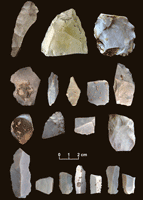
Archaeologists dig at the Debra L. Friedkin site at Buttermilk Creek in central Texas.
(Courtesy Michael R. Waters)
In mid-October 2011 the journal Science published a reexamination of a mastodon bone originally excavated in the late 1970s at the Manis site in northwestern Washington State. Embedded in the bone, one of the mastodon's 19 ribs, was the tip of a bone projectile. Using DNA analysis, a team led by Texas A&M University archaeologist Michael Waters determined that the point was itself fashioned from
mastodon bone.
Radiocarbon dating of the rib and projectile indicate they are 13,800 years old, predating the so-called "Clovis horizon," roughly 11,000 years ago, when the Clovis culture, associated with fluted, stone points shaped like a Catholic bishop's hat, first emerged in the archaeological record. In the 1930s archaeologists identified these Clovis toolmakers as the original settlers of the Americas. These Paleoindians may have crossed the now-submerged landmass in the Bering Strait from northeastern Asia. The Manis mastodon is the latest in more than a decade of findings prompting archaeologists to consider that there might have been earlier migrations of settlers.
"We've known there's pre-Clovis for a long time," says Gary Haynes of the University of Nevada, Reno. Adds James Adovasio, an archaeologist at Mercyhurst College in Erie, Pennsylvania: "What you're seeing is the emergence of ideas that reflect the current ferment in the field now that we know this old model doesn't work."

A mastodon rib found at the Manis site in Washington State has a bone projectile
lodged in it.
(Courtesy Center for the Study of First Americans)

Chert tools from Buttermilk Creek date to 15,500 years ago and some show evidence of bifacial technology.
(Courtesy Michael R. Waters)
Change is afoot, but it's not a unanimous shift, says David G. Anderson, an archaeologist at the University of Tennessee. He notes that in a survey administered by one of his graduate students to 200 Paleoindian researchers, 70 percent acknowledged there had to be pre-Clovis populations in the Americas. "The problem is," Anderson explains, "we know so little about pre-Clovis that we need really well documented sites."
Waters' other work at the Debra L. Friedkin site on Buttermilk Creek in central Texas, published in March 2011, also in Science, fits Anderson's bill. There, in perfect stratigraphical alignment, archaeologists found the remains of tools left behind by different Archaic period hunter-gatherers sitting above those of various Paleoindian cultures. The team believes the oldest layer, containing 20,000 pieces made of chert, a sedimentary rock—with roughly 100 discernable tools such as blades, choppers, and end scrapers—dates to 15,500 years ago, 2,500 years before
Clovis technology.
The assemblage found at Buttermilk Creek does not resemble those at several previously found pre-Clovis sites, such as the 14,500-year-old tools from Monte Verde in southern Chile. Its incorporation of bifacial and bladelet technology does recall Clovis culture, suggesting a lineage between the two. "There's a logical expectation that somewhere in North America we are going to find something that can be called proto-Clovis," says Stuart Fiedel, an archaeologist at the Louis Berger Group in Richmond, Virginia.
The report on Buttermilk Creek, as with other potential pre-Clovis discoveries, sparked fierce debate among Paleoindian researchers about the accuracy of the findings. Fiedel notes the assemblage could be characterized as a fluted point away from being a Clovis toolkit. "It has similarities to Clovis," says Waters. "But it's not Clovis in the strict definition."
Critics slammed Waters on his dating method, optically stimulated luminescence, which essentially measures when crystals in surrounding sediment, such as quartz, were last exposed to sunlight, as opposed to measuring the artifacts themselves. It's as accurate as radiocarbon dating, but less precise, with greater margin for error. Waters also fielded criticism of the Manis mastodon analysis, with detractors pointing out that the DNA analysis couldn't confirm the bone projectile came from a different animal, meaning a bone fragment from the same beast may have pierced its own rib. Waters notes that butcher marks on the mastodon bones refute that interpretation.
Adovasio explains that American archaeologists are behind their South American and European colleagues in accepting people prior to Clovis being in the Americas. He even points to Science—which he calls "the last bastion of conservatism in this arena"—publishing Waters' reports as an indication of the tide turning. "Science," he says, "is about changing your mind when confronted with alternative data that seems plausible," he says.

